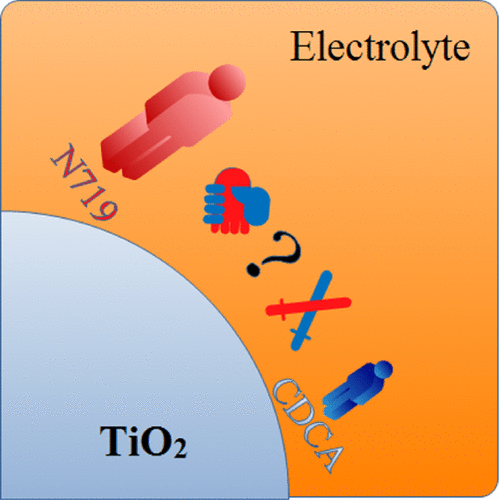当前位置:
X-MOL 学术
›
ACS Appl. Energy Mater.
›
论文详情
Our official English website, www.x-mol.net, welcomes your feedback! (Note: you will need to create a separate account there.)
In Situ Evaluation of Kinetics and Interaction Mechanism between Chenodeoxycholic Acid and N719 on Dye-Sensitized Nanofilm Surface
ACS Applied Energy Materials ( IF 6.4 ) Pub Date : 2020-03-26 00:00:00 , DOI: 10.1021/acsaem.9b02321 Weiqing Liu 1, 2 , Haiyan Jiang 1, 2 , Jing Shi 1, 2 , Bingjun Lu 1, 2 , Hongfeng Cai 1, 2 , Zhimin Mao 1, 2 , Fantai Kong 3
ACS Applied Energy Materials ( IF 6.4 ) Pub Date : 2020-03-26 00:00:00 , DOI: 10.1021/acsaem.9b02321 Weiqing Liu 1, 2 , Haiyan Jiang 1, 2 , Jing Shi 1, 2 , Bingjun Lu 1, 2 , Hongfeng Cai 1, 2 , Zhimin Mao 1, 2 , Fantai Kong 3
Affiliation

|
The photoanode of a dye-sensitized solar cell is composed of titanium dioxide and a dye adsorbed on the surface. Dye molecules, such as N719 dye, usually agglomerate due to H bond and other factors, forming a multilayer adsorption structure, leading to light loss and electron injection loss. Adding a co-adsorbent to the dye, such as chenodeoxycholic acid (CDCA) molecule, is an effective method to prevent the aggregation of the dye. However, the mechanism of interaction between CDCA and N719 is still unclear. Therefore, in this paper, the mechanism of interaction of CDCA and N719 was studied in detail using quartz crystal microbalance (QCM) combined with UV–vis absorption spectrum. The adsorption kinetics constant of the co-adsorbent CDCA was obtained, and it was found that the adsorption process of CDCA on the surface of TiO2 was more consistent with the Freundlich isothermal adsorption model. Under the condition of continuous adsorption and desorption, the dynamic constants of CDCA adsorption did not change obviously, but molecular rearrangement might occur. In the process of sequential competitive adsorption, pretreatment with CDCA had a small influence on the adsorption kinetic constants of N719. There is competitive adsorption between CDCA and N719 on the surface of TiO2. In the process of mixed adsorption, the interaction mechanism between CDCA and N719 is a cooperative mechanism in the solution and competitive mechanism on the TiO2 surface. In addition, the results of this experiment also showed that CDCA could accelerate the adsorption time of N719. The experimental results in this paper may be helpful for understanding the mechanism of CDCA.
中文翻译:

染料敏化的纳米膜表面上去氧胆酸与N719的动力学及相互作用机理的原位评价
染料敏化太阳能电池的光阳极由二氧化钛和吸附在表面的染料组成。诸如N719染料的染料分子通常由于H键和其他因素而聚集,形成多层吸附结构,从而导致光损失和电子注入损失。向染料中添加辅助吸附剂(例如鹅脱氧胆酸(CDCA)分子)是防止染料聚集的有效方法。但是,CDCA和N719之间的相互作用机制仍不清楚。因此,在本文中,结合石英微天平(QCM)和紫外可见吸收光谱,详细研究了CDCA与N719的相互作用机理。得到了共吸附剂CDCA的吸附动力学常数,发现CDCA在TiO 2表面的吸附过程2与Freundlich等温吸附模型更一致。在连续吸附和解吸条件下,CDCA吸附的动力学常数没有明显变化,但可能发生分子重排。在连续竞争吸附过程中,CDCA预处理对N719的吸附动力学常数影响很小。TiO 2表面上CDCA与N719之间存在竞争性吸附。在混合吸附过程中,CDCA与N719的相互作用机理是溶液中的协同机理,也是TiO 2上的竞争机理。表面。另外,该实验的结果还表明,CDCA可以加速N719的吸附时间。本文的实验结果可能有助于理解CDCA的机制。
更新日期:2020-03-26
中文翻译:

染料敏化的纳米膜表面上去氧胆酸与N719的动力学及相互作用机理的原位评价
染料敏化太阳能电池的光阳极由二氧化钛和吸附在表面的染料组成。诸如N719染料的染料分子通常由于H键和其他因素而聚集,形成多层吸附结构,从而导致光损失和电子注入损失。向染料中添加辅助吸附剂(例如鹅脱氧胆酸(CDCA)分子)是防止染料聚集的有效方法。但是,CDCA和N719之间的相互作用机制仍不清楚。因此,在本文中,结合石英微天平(QCM)和紫外可见吸收光谱,详细研究了CDCA与N719的相互作用机理。得到了共吸附剂CDCA的吸附动力学常数,发现CDCA在TiO 2表面的吸附过程2与Freundlich等温吸附模型更一致。在连续吸附和解吸条件下,CDCA吸附的动力学常数没有明显变化,但可能发生分子重排。在连续竞争吸附过程中,CDCA预处理对N719的吸附动力学常数影响很小。TiO 2表面上CDCA与N719之间存在竞争性吸附。在混合吸附过程中,CDCA与N719的相互作用机理是溶液中的协同机理,也是TiO 2上的竞争机理。表面。另外,该实验的结果还表明,CDCA可以加速N719的吸附时间。本文的实验结果可能有助于理解CDCA的机制。



























 京公网安备 11010802027423号
京公网安备 11010802027423号